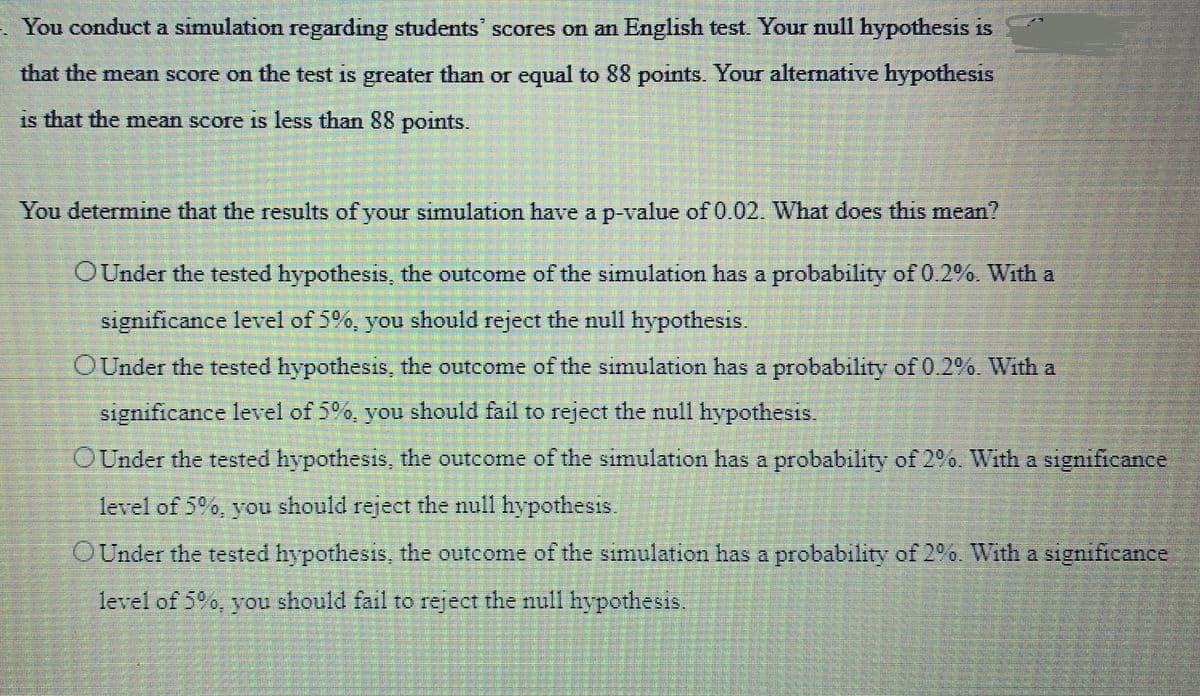You conduct a simulation regarding students' scores on an English test. Your null hypothesis is that the mean score on the test is greater than or equal to 88 points. Your alternative hypothesis is that the mean score is less than 88 points. You determine that the results of your simulation have a p-value of 0.02. What does this mean? OUnder the tested hypothesis, the outcome of the simulation has a probability of 0.2%. With a significance level of 5%, you should reject the null hypothesis. OUnder the tested hypothesis, the outcome of the simulation has a probability of 0.2%. With a significance level of 5%, you should fail to reject the null hypothesis. OUnder the tested hypothesis, the outcome of the simulation has a probability of 2%. With a significance level of 5%, you should reject the null hypothesis. OUnder the tested hypothesis, the outcome of the simulation has a probability of 2%. With a significance level of 5%, you should fail to reject the null hypothesis.
You conduct a simulation regarding students' scores on an English test. Your null hypothesis is that the mean score on the test is greater than or equal to 88 points. Your alternative hypothesis is that the mean score is less than 88 points. You determine that the results of your simulation have a p-value of 0.02. What does this mean? OUnder the tested hypothesis, the outcome of the simulation has a probability of 0.2%. With a significance level of 5%, you should reject the null hypothesis. OUnder the tested hypothesis, the outcome of the simulation has a probability of 0.2%. With a significance level of 5%, you should fail to reject the null hypothesis. OUnder the tested hypothesis, the outcome of the simulation has a probability of 2%. With a significance level of 5%, you should reject the null hypothesis. OUnder the tested hypothesis, the outcome of the simulation has a probability of 2%. With a significance level of 5%, you should fail to reject the null hypothesis.
Chapter9: Sequences, Probability And Counting Theory
Section9.7: Probability
Problem 1SE: What term is used to express the likelihood of an event occurring? Are there restrictions on its...
Related questions
Question
100%
Statistics Question

Transcribed Image Text:You conduct a simulation regarding students' scores on an English test. Your null hypothesis is
that the mean score on the test is greater than or equal to 88 points. Your alternative hypothesis
is that the mean score is less than 88 points.
You determine that the results of your simulation have a p-value of 0.02. What does this mean?
OUnder the tested hypothesis, the outcome of the simulation has a probability of 0.2%. With a
significance level of 5%, you should reject the null hypothesis.
OUnder the tested hypothesis, the outcome of the simulation has a probability of 0.2%. With a
significance level of 5%, you should fail to reject the null hypothesis.
OUnder the tested hypothesis, the outcome of the simulation has a probability of 2%. With a significance
level of 5%, you should reject the null hypothesis.
OUnder the tested hypothesis, the outcome of the simulation has a probability of 2%. With a significance
level of 5%, you should fail to reject the null hypothesis.
Expert Solution
This question has been solved!
Explore an expertly crafted, step-by-step solution for a thorough understanding of key concepts.
This is a popular solution!
Trending now
This is a popular solution!
Step by step
Solved in 2 steps

Recommended textbooks for you

